
Joe Buffington Quigley was born in Kitanning, Pennsylvania in 1869, and became one of the early Alaskan pioneers. He told Ranger Grant Pearson [3] that he had entered Alaska by crossing the pass from Dawson on his 22nd birthday (May 9, 1891), and was later one of the first white men to cross the Chilkoot Pass.
Joe Quigley was my grandmother’s father’s brother, and thus, my great (2) uncle Our family is proud that Joe and Fanny are part of our history.
Joe had been mining in the north for nearly 10 years along the Forty Mile River before the Klondike stampede. He returned to Dawson, and found the claims mostly taken. Instead, he prospected along the Copper River and joined the rush to Tanana and prospected near Fairbanks.
He then moved on to prospecting at Kantishna, inside today’s Denali Park, near Mount McKinley in 1905. Perhaps it was on a return to Fairbanks to file a claim that he became seriously ill with typhoid and was nursed back to health by Fanny MacKenzie who had been working as a cook and housekeeper In Fairbanks.
Fannie Sedlacek

Francis Sedlacek (always called Fannie) was born in Wahoo, Nebraska in 1870 to Bohemian immigrants Vencil and Josephine Sedlacek [1]. They had 3 daughters and a baby boy when Josephine died. Vencil quickly remarried Mary Tomes and they had 2 more children. Farming did not go well for Vencil because of the variable weather, and he lost his farm and began renting land. The family was very poor and lived in a dugout, more primitive than the sod hut Laura Ingalls described.
When they were old enough, Fannie and her older sister were sent to “work out,” to bring in some more income. It was at this point that Fannie at age 16 left home and began working along the construction of the Burlington Railroad, probably as a waitress or cook’s helper.
Since she was working for the food catering company, there are no records of exactly where she actually worked from 1886 to 1898, although for the most part it was following the railroad west. When she left home, she had had barely 2 years of schooling and was not only illiterate, but spoke only Czech, so letters and postcards to her sisters came much later.
Fannie became an official prospector when she was issued a Free Miner’s Certificate in 1899 for Hunker Creek near Dawson. She was also working at a nearby roadhouse, probably as a cook. She followed some of the smaller gold rushes out of the area and soon realized she would do better selling meals. She set up a tent and a portable stove, hung out a “Meals for Sale” sign, and sold meals to the miners for a dollar, realizing that miners had no time to make meals after long days looking for gold.
Surprisingly, after the claims petered out, she returned to Dawson (Yukon territory) and married the handsome Canadian, Angus McKenzie in October, 1900. They set up a roadhouse near Hunker Creek providing meals, liquor and possibly some lodging. This marriage was punctuated with liquor soaked fights, one of which landed the two of them in court in December of 1901. By the end of 1902, Fannie had had enough, and walked out on McKenzie in January of 1903, and walked 700 miles to Rampart, Alaska in the dead of winter, and eventually down to Chena and Fairbanks.

Fannie spent nearly 3 years in and around Fairbanks, probably working as a cook or housekeeper, but she staked her first claim in March, 1904 on Alder Creek. We assume this is where she first met Joe.
Fannie and Joe
Fannie moved to Glacier City in the Kantishna area in 1905, with her Meals for Sale tent , but by 1906 had moved in with Joe Quigley in Glacier Creek. She filed 26 claims in the area as “F McKenzie” or “Mrs McKenzie.” There is no evidence that she ever divorced Angus nor that he had died: there does not seem to be any death record for him. While he was in the Fairbanks area soon after Fannie was, he seems to have disappeared. She did operate a roadhouse called “Mother McKenzie’s Cabin” in 1913 and registered her claims under the name of McKenzie. She and Joe were formally married in 1918.
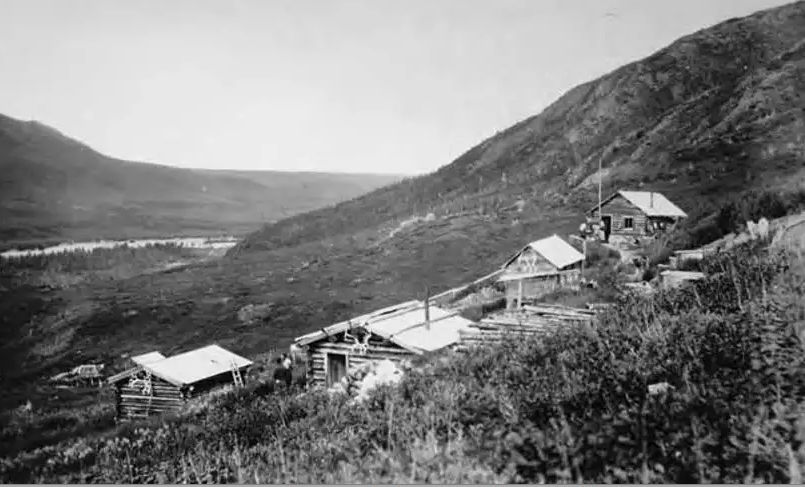
Soon after their marriage, they moved to a ridge in Kantishna that is still called Quigley Ridge. They constructed 4 cabins, one for themselves, one for guests, and one for storage. The last one may have been for their dogs, who provided their only transportation.
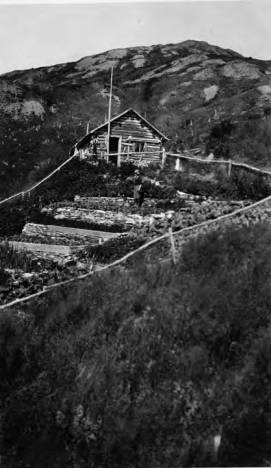
Fannie dug a large garden and raised vegetables despite Alaska’s having only 10 frost-free weeks a year. The summer days were very long, however. Pictures seem to show raised beds and a sort of a canvas cover to lengthen the season. She raised “all kinds of berries,” lettuce, cauliflower, celery, rhubarb, onions potatoes, cucumbers and even some tomatoes. She became an excellent hunter and trapper, providing all their meat and enough to serve fine dinners to guests.
She picked gallons of wild blueberries and cranberries as well. Most fascinating was that an abandoned miner’s tunnel behind their cabins was under the permafrost and she used it as a refrigerator and freezer. Park Ranger Grant Pearson [4] described her larder as containing “sides of caribou, moose, bear, skinned and cleaned rabbits, porcupines, ptarmigan, and shelves of dozens of pies, cakes, bread, rolls and doughnuts, all frozen hard as rocks.” He said she had a 5 year jump on Clarence Birdseye, who was supposed to have discovered quick freezing. She also had a closed room with a series of doors that kept it at about 40 degrees where she kept all her vegetables. She was noted for her pies and the flakey piecrusts that she made from lard rendered from bear fat. They only imported sugar and flour and some eggs. Everything else they ate came from Fannie (and Joe’s) hunting and their garden.
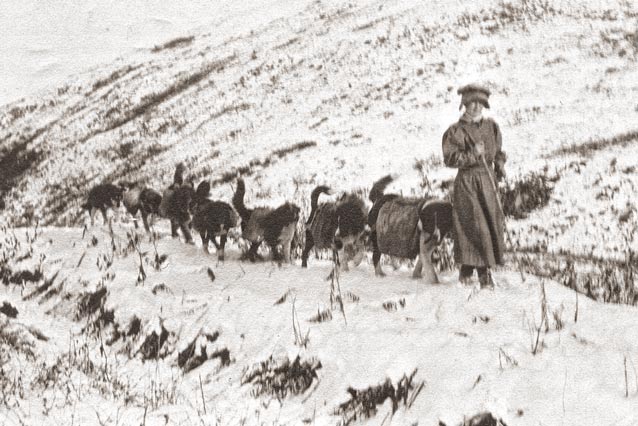
One of the great stories Fanny told was the time she spotted a moose, but was pretty far from her cabin [8]. It would be dark soon, and if she shot the moose and went home, animals would have gotten it by morning. She didn’t have any sleeping gear with her, so she shot the moose, gutted it, and climbed inside to spend the night. In the morning, the blood had frozen and she said she “had a heck of a time” chipping her way out. But she did get that moose home. This is one of those almost “tall tales” you hear from hunters, and historian Jane Haigh [1] is skeptical of it. But with the added detail of being frozen inside the moose, it seems pretty likely to be true. This story was used by Edna Ferber, in her book Ice Palace. This story was also confirmed by my grandmother who had heard it through the family.
Joe’s mining moved to Quigley Ridge and while they continued to find small amounts of gold to pay their yearly expenses, he also discovered a vein of galena (silver and lead) and quartz. Over the years he studied mineralogy during the winter. He set up an assaying outfit and was able to assay the ore he and his friends had dug. We also know that he and Fannie visited Quigley relatives in Oakmont, PA in 1922, as shown in the photo at the bottom of this article.
In 1930, Joe was seriously injured in a mining tunnel collapse. He was working so far from their cabin that Fannie brought him supplies every few days. He had crawled to the front of the tunnel and Fannie helped him to his tent, built a fire in the stove and fed him soup. Fannie discovered he had broken his hip and a shoulder, and she went for help.
Meanwhile, the stove in Joe’s tent exploded. Fanny had accidentally used wood shavings instead of wood chips in her hurry, and Joe watched the fire approach his bed. Fortunately, there were two trails of shavings and they met and burned themselves out. He never told Fanny.
A neighbor, Johnny Busia, hiked 40 miles to a telephone so he could summon a plane and a doctor. The plane arrived on June 1 and took Joe to the Fairbanks hospital, where he remained until September 24. When he returned he was partially disabled. He couldn’t raise his arms over his head and one leg was longer than the other: he couldn’t do much mining. This is when he began development work, seeking to find mining companies to sell their mines to.
Joe finally succeeded (“struck it medium rich”) selling his Red Top Mine near Eureka in 1937, for $100,000 plus royalties. The mine provided gold and silver ore and quartz. The mining company began bringing in equipment and it was running from 1939-1942.
Joe and Fannie spent less and less time together during this development period, and in April 1937, they decided to split the proceeds and divorce. (There is no record of this divorce that I can find, even in the newspapers.)
Joe
When Joe left Alaska, It has been said that he moved to Seattle and married a nurse named Julia [1] who had cared for him in Fairbanks. But all evidence seems to show that this is a myth. I can find no record of his marriage, nor do either of them appear in the 1940 census. Nor is there any article in the gossipy Alaskan press announcing the marriage. Further, no articles about Joe after that date mention a wife. Haigh’s book [1] attributes this marriage story to Grant Pearson, who had become Park Superintendent, but neither of his articles in Alaskan Sportsman nor his book mentions a wife [2, 3, 4].
In fact, it appears that Joe did not remarry, but first travelled south to Hot Springs, Arkansas [10] and spent some of the 1937-38 winter using the warm waters to help heal his mining injuries. After some travel, he returned to Fairbanks, but left for Seattle for the winter on September 20, 1938.
He returned to Fairbanks in 1939 by steamship on April 15 to celebrate his 70th birthday on May 8 [12], and gave a presentation on all the old miners he had run into in his travels. Joe had not been sitting still, but had driven 17,000 miles all over the US in 1937-8, spending time in Florida, California and Mexico City.
In the winter of 1938-9, he drove another 14,000 miles, visiting Chicago, Detroit, the East Coast, Key West, Nevada and Arizona.
While in Alaska in 1939, he took up some prospecting, leaving in September , and returning in June, 1940, when he discussed [13] all the mining opportunities he’d seen in Oregon. He returned in June of 1941 [14]. The reporter noted that he had almost entirely recovered from his injury, and looked better than he had in years. Joe left Fairbanks for Seattle on Aug 12, 1941 [15] and is not mentioned further in the papers.
In Grant Pearson’s article, he mentions visiting Joe in Fairbanks in 1945 [3] and while Grant asked if he planned to return to Alaska, his eyes lit up, but said he didn’t plan to do so. Joe was mentioned in the 1952 paper [16] as one of seven remaining members of the Pioneers of Alaska, who had arrived before 1899.
Joe died in Seattle in 1958 at the age of 89. As far as I know, none of his eastern family knew he was living there. The obituary in the Seattle Times mentions two relatives: Vernon Quigley of Portland and Mrs Joseph Morgan of Long Beach, CA.
Fannie
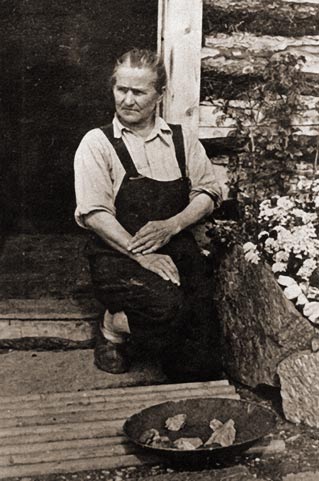
Fannie remained in her beloved Kantishna, with a view of Mt McKinley, but the mining company built her a new frame house near the Moose Creek airstrip, so she wouldn’t be disturbed by the mining activity. This allowed her to get to Fairbanks more easily using the mining company’s flights. In 1938, we read that she spent the winter in the Pioneer Hotel in Fairbanks. The newspaper [ 11] indicates that a pilot had ferried supplies to Kantishna for her, and that she would return to her home in about a week.
In August of 1944, neighbor Johnny Busia noticed that there was no smoke coming from Fannie’s house. She had died that night. The newspaper described her at her funeral as “the droll, spunky and tenacious little pioneer, so well known and loved throughout Alaska.” [17]
Joe and Fanny were well known because they entertained guests regularly, including Jack London and other writers. Joe was best known for his mining and mineralogy expertise as well as his personal kindness, and Fanny for her hunting and wilderness cooking skills. Together they made the area around Denali Park and Mt McKinley so attractive to visitors that it became a significant tourist attraction. Joe was also an excellent photographer, developing and printing his own photos, and many of his photos can be found in the Fannie Quigley Collection [9] at the University of Alaska.

References
- Jane G Haigh, Searching for Fannie Quigley, Ohio University Press, 2007
- Grant Pearson, “Fannie Quigley, Frontierswoman” Alaskan Sportsman, August, 1947.
- Grant Pearson, “Joe Quigley, Sourdough,” Alaskan Sportsman, March, 1950 http://bit.ly/2sRDFvq
- Grant Pearson with Philip Newill, My Life of High Adventure, Prentice Hall, Englewood Cliffs, NJ:
- “Fannie Quigley,” National Park Service, Denali. http://bit.ly/2rWZhVI
- “Kantishna Gold,” National Park Service, Denali, http://bit.ly/2rXier9
- “Denali,” National Park Service, Denali, http://bit.ly/2rs3v45
- “Fannie Quigley, An Alaskan Folk Hero,” Last Frontier, Oct 2, 2014. http://bit.ly/2tiuG2u (essentially copied from Pearson’s article in ref 2)
- “The Fannie Quigley Collection,” University of Alaska, http://bit.ly/2rsbL40
- The Alaska Miner, Sept 20, 1938, page 24. http://bit.ly/2sQUt5M
- The Alaska Miner, Feb 15, 1938, page 7.. http://bit.ly/2tLwv8k
- Fairbanks Daily News Miner, May 8, 1939, page 2. http://bit.ly/2tqCIr7
- Fairbanks Daily News Miner, June 21, 1940, page 7. http://bit.ly/2tLnxYX
- Fairbanks Daily News Miner, June 10, 1941, page 5. http://bit.ly/2rOHotJ
- Fairbanks Daily News Miner, Aug 12 , 1941, page 4. http://bit.ly/2sopdJS
- Fairbanks Daily News Miner, Nov 13, 1952 page 6. http://bit.ly/2sAnLTj
- Fairbanks Daily News Miner, Sept 2, 1964, page 6. http://bit.ly/2sT8Fv1

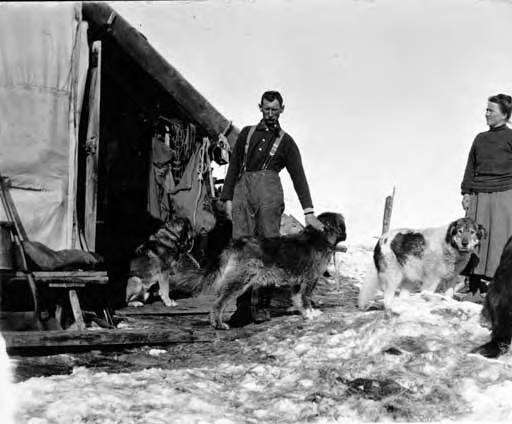
What a great post and wonderful photos. No wonder you’re proud of them!
LikeLike
Thanks for sharing their story
LikeLike
These people are my ancestors and I’m very proud of their adventures.
LikeLike